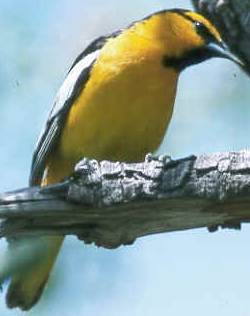|
| Query: Bird's wing | Result: 6th of 39 | |
Bullock's Oriole (Icterus bullockii) - Wiki
| Subject: | Bullock's Oriole (Icterus bullockii) - Wiki
| |

| Resolution: 250x316
File Size: 11653 Bytes
Upload Date: 2007:09:27 09:14:11
|
Bullock's Oriole
From Wikipedia, the free encyclopedia
[Photo] Male Bullock's Oriole, Icterus bullockii from US FWS. Source: U.S.Fish and Wildlife Service, Klamath Basin NWR. Rights: public domain
The Bullock's Oriole, Icterus bullockii, is a small blackbird. At one time, this species and the Baltimore Oriole were considered to be a single species, the Northern Oriole.
Adults have a pointed bill. The adult male is orange on the underparts, face and rump with black everywhere else; they have a white wing patch. The adult female is grey-brown on the upper parts, dull yellow on the breast and belly and has wing bars.
Their breeding habitat is the edges of deciduous and mixed woods across western North America. The range of this bird overlaps with that of the similar Baltimore Oriole in the east; these two birds sometimes interbreed where their ranges overlap. The nest is a tightly woven pouch located on the end of a branch.
These birds migrate to Mexico and Central America.
These birds forage in trees and shrubs, also making short flights to catch insects. They mainly eat insects, berries and nectar.
This bird's song is similar to that of the Baltimore Oriole, but faster and somewhat more harsh.
This bird was named after William Bullock, an English amateur naturalist.
Interesting Bullock's Oriole Facts
??? In the 1800s an ornithologist concluded that the Baltimore Oriole and Bullock’s Oriole were one and the same species and grouped them under one name ??? the Northern Oriole. More recent studies show that in fact they are two distinct species and they were categorized separately again. However, these two birds hybridize often, especially when they meet at the Great Plains.
??? Male Bullock’s Orioles sing a different song from their female counterparts. The female’s song often sounds harsher but she sings more than the male bird.
Read more About The Bullock's Oriole at http://www.birdhouses101.com/bullocks-oriole.asp
http://en.wikipedia.org/wiki/Bullock%27s_Oriole
| The text in this page is based on the copyrighted Wikipedia article shown in above URL. It is used under the GNU Free Documentation License. You may redistribute it, verbatim or modified, providing that you comply with the terms of the GFDL. |
|
Comments |
|---|
| | Guest |
|
Bullock's Oriole (Icterus bullockii)
French: Oriole de Bullock German: Bullocktrupial Spanish: Turpial de Bullock
Other common names: Northern Oriole (when lumped with I. galbula)
Taxonomy: Xanthornus Bullockii Swainson, 1827, “Table land” [of Mexico] = Temascáltepec, México State, Mexico.
DNA data indicate that present species is sister to I. pustulatus. In the past usually treated as conspecific with I. galbula and I. abeillei. Hybridizes extensively with former in a belt from S Canada (Alberta and Saskatchewan) S in Great Plains to S USA (Oklahoma and Texas), but assortative mating (or selection against hybrids) evident at several locations. Smaller race parvus possibly not worthy of recognition, and size difference within species apparently clinal; retained pending further study. Proposed race eleutherus (from N Texas, in S USA), supposedly more orange than nominate, considered to fall within range of variation of latter. Two subspecies tentatively recognized.
Subspecies and Distribution
I. b. bullockii (Swainson, 1827) – breeds SW Canada (from S British Columbia, S Alberta and SW Saskatchewan) S in W USA (except C California S to W Arizona) to N Mexico (Sonora, Chihuahua and Coahuila); winters C Mexico S to C Guatemala.
I. b. parvus van Rossem, 1945 – breeds SW USA (from C California, S Nevada and W Arizona) S to NW Mexico (extreme N Baja California and extreme NW Sonora); winter range uncertain. |
^o^
Animal Pictures Archive for smart phones
^o^
|
|
|